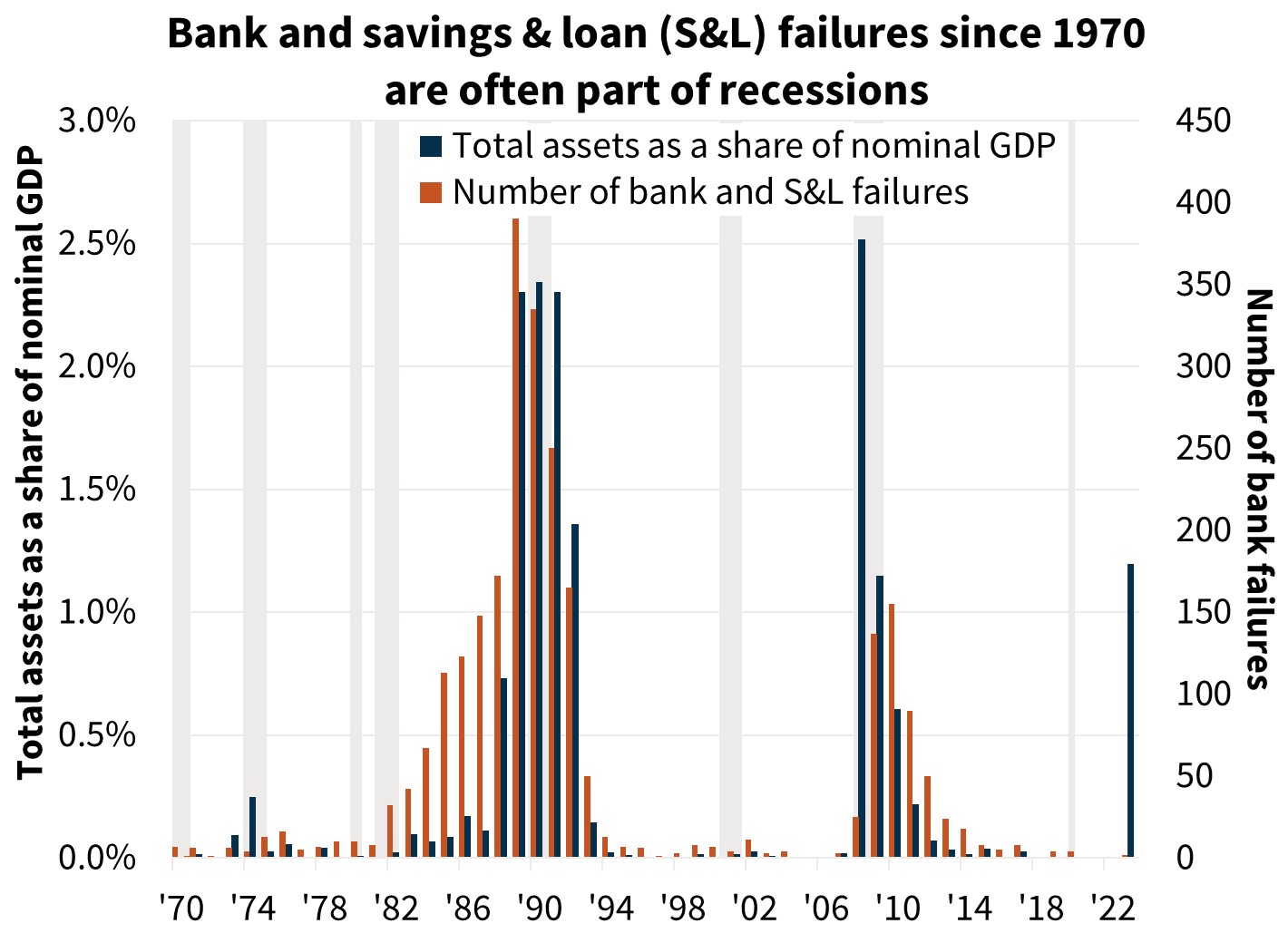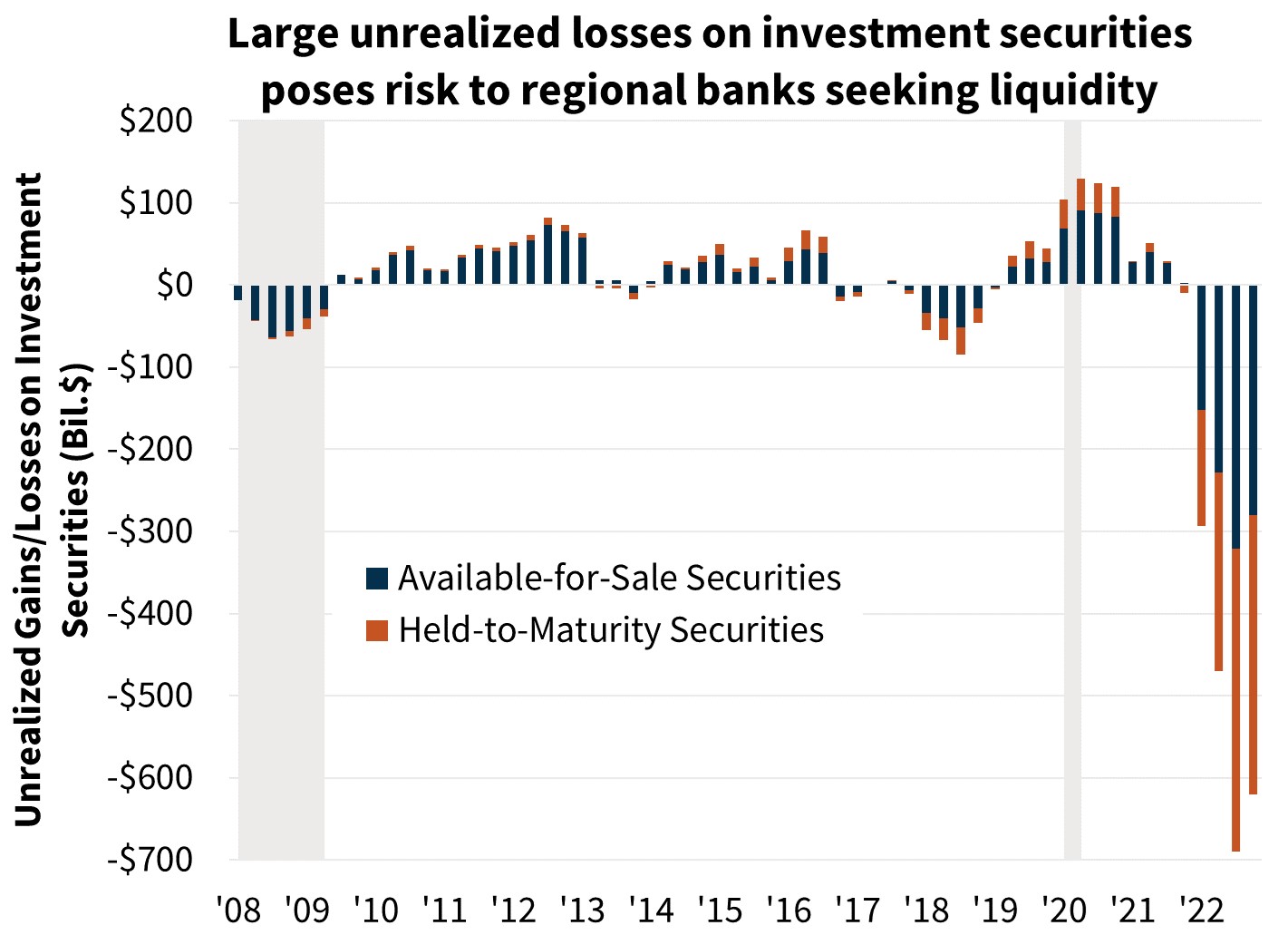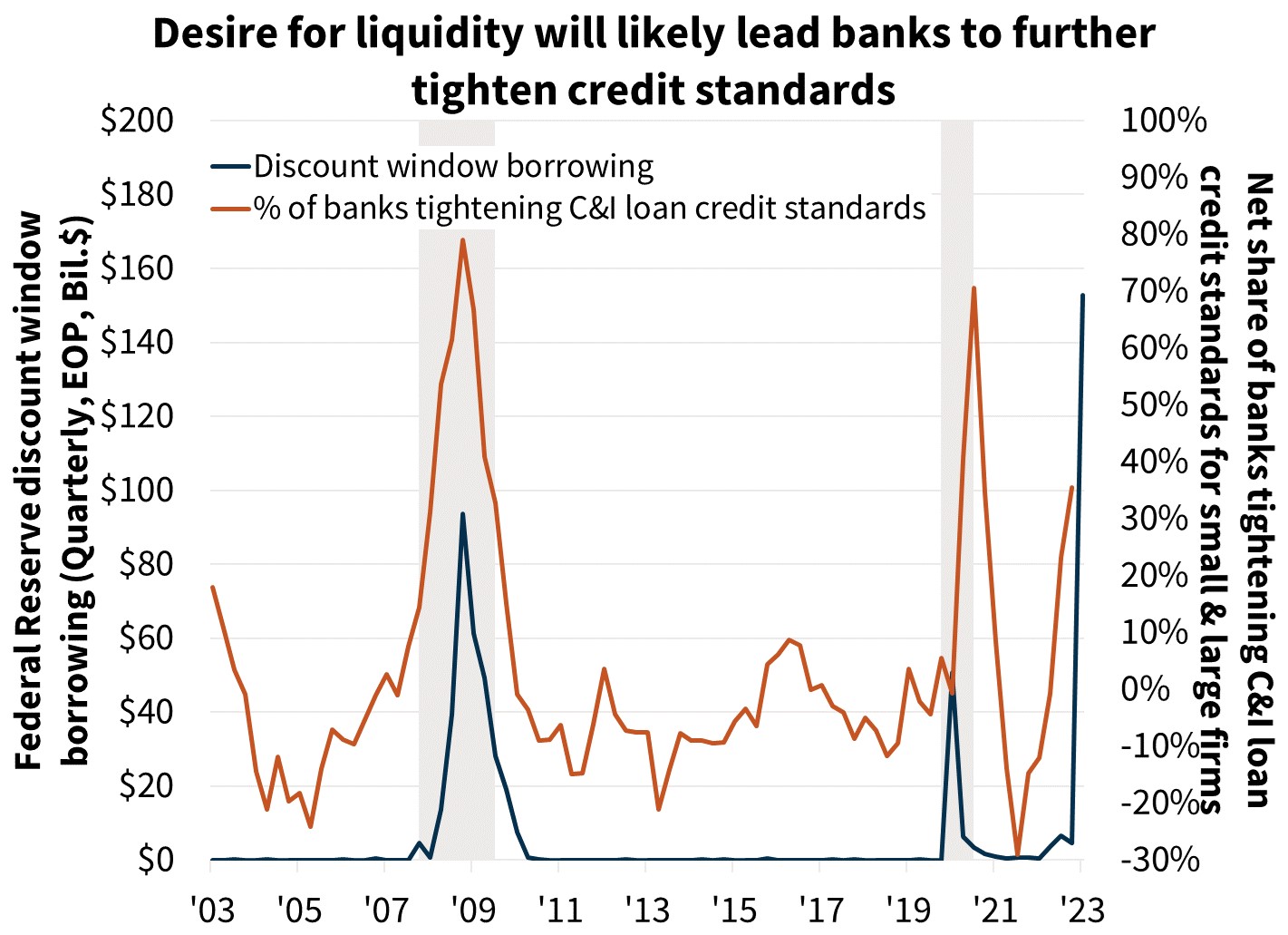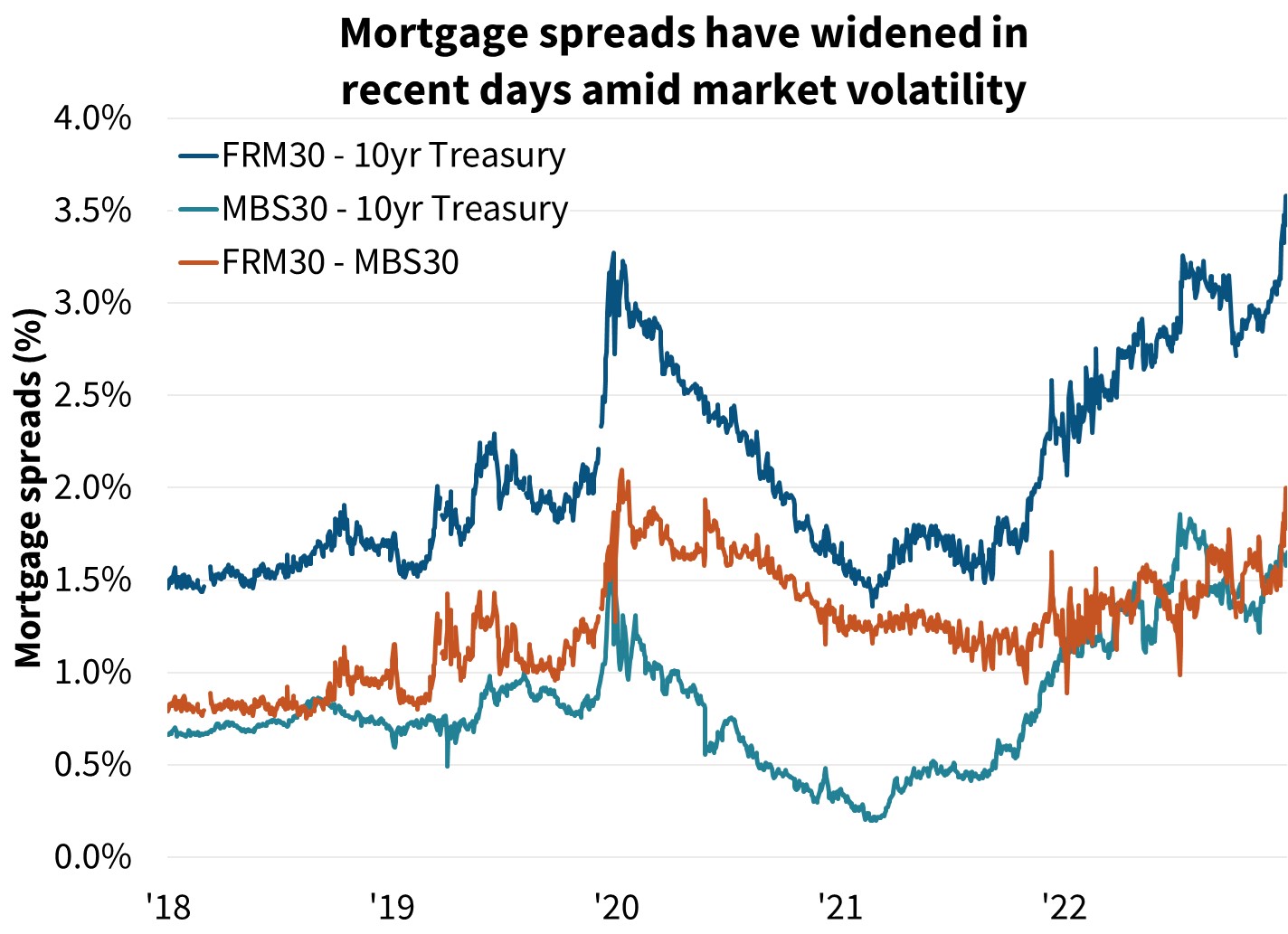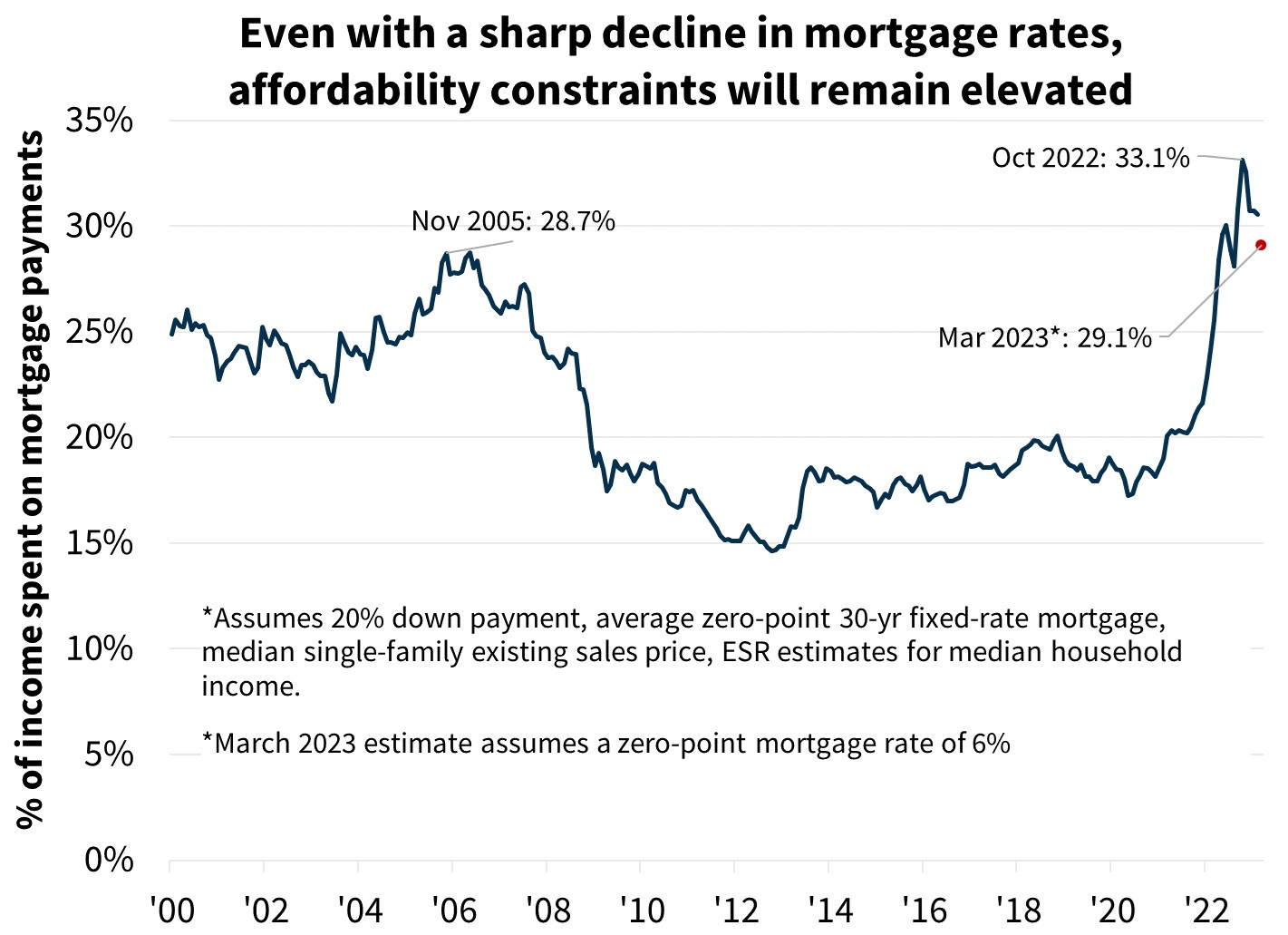Banking Turmoil May Precede Long-Awaited Recession
Uncertainty regarding our latest macroeconomic forecast, which we finalized on March 13, has risen in the wake of the recent turbulence in the banking sector, following the failures of Silicon Valley Bank and Signature Bank, as well as troubles with Credit Suisse. However, as of this writing (March 21), we don’t believe these events fundamentally change our baseline outlook. We already expected a moderate economic contraction to occur this year, and, historically, turbulence in financial markets and the formal banking sector have often been a characteristic of late business cycle dynamics following monetary policy tightening. Many typical recessions have historically included bank failures as an attribute.
Prior to recent banking events, economic data continued to point to stronger-than-expected growth in the first quarter, including large upward data revisions following the completion of our prior forecast. Employment and consumer spending continue to show resilience, and core inflation measures remain elevated. Our updated forecast increases the Q1 2023 real gross domestic product (GDP) estimate and pushes out the timing of an anticipated recession from Q2 2023 into the second half of this year. While the projected timing has been adjusted, many leading indicators, including extreme weakness in the Conference Board’s Leading Economic Index® (LEI) and other business surveys, continue to point toward future economic contraction. Furthermore, we believe the level of personal consumption will retrench at a slower pace, as its current level relative to income remains unsustainable.
We now expect Q1 2023 GDP to grow 0.9 percent annualized, up from our prior expectation of a contraction of 0.4 percent. On a Q4/Q4 basis, we upgraded our 2023 growth forecast to negative 0.3 percent from negative 0.5 percent, while downgrading our 2024 growth forecast to 1.2 percent from 1.8 percent, reflecting the later start of the expected recession, though the total projected peak-to-trough decline is similar to last month’s forecast. We forecast the unemployment rate to begin moving meaningfully upward around mid-year and to end 2024 above 5 percent.
For our housing forecast, consistent with the change in timing of our GDP outlook and the update to our interest rate forecast, we revised upward total home sales for Q1 2023 but expect a larger contraction later in the year. We expect total home sales in 2023 to decline 18.4 percent from the 2022 total (previously a 17.6 percent decline) followed by a partial rebound in 2024, with home sales rising 7.1 percent for the year (previously 9.6 percent). Similarly, we modestly downgraded our forecast for total single-family mortgage originations in 2023 to $1.55 trillion (previous $1.69 trillion) and in 2024 to $1.89 trillion (previously $2.03 trillion).
It should be noted that our interest rate forecast was completed prior to the recent bank failure events and thus does not reflect the sharp drop in long- and intermediate-term interest rates following those events. This represents downside risk to our mortgage rate forecast and upside risk to home sales and mortgage originations.
Bank Failures Are Often Part of Recessions (Not Just the Great Recession)
Due to recency bias, many observers likely associate bank failures with the 2008 Financial Crisis and the deep resulting recession. However, we do not see many parallels between the current turmoil and what preceded the 2008 crisis. Typically, at least a few bank failures occur in or around even mild contractions, as economic conditions expose weak or overly risky institutions. While both recent events and the 2008 Financial Crisis involved liquidity crises (bank runs from regional banks currently compared to a run on the informal banking system in 2008), the similarities between the two periods largely end there. The underlying problems in 2008 were deteriorating credit performance on mortgages, many borrowers finding themselves underwater on their loans, and related heavy losses being realized by undercapitalized financial institutions. In contrast, in the current episode, the banking system is not only far less leveraged, but credit performance is not deteriorating. Rather, the shock being felt by the banking system is the past year’s rapidly rising interest rates and the shrinking of aggregate deposits in the system as monetary policy tightened and depositors sought higher yields. This has resulted, in effect, in large mark-to-market losses on long-dated assets while also increasing the demand for deposit redemptions. Financial institutions with minimal or hedged duration risk on their portfolios and stable sources of funding are likely not in acute danger as credit quality remains strong, capital remains high by historical standards, and, most recently, policy measures have been put into place intended to prevent further bank runs (though risk of additional bank failures remains).
To the extent that there is a historical parallel, we see more similarities to the first shock in the Savings & Loan (S&L) crisis in the early 1980s. Like today, aggressive monetary policy tightening occurred in response to high inflation. S&Ls by legal definition at the time were largely limited to funding mortgage loans and by the nature of the business held mostly long-dated, fixed-rate assets on their balance sheets. Additionally, the law limited how high interest rates could be offered on deposits. When the fed funds rate spiked in the early 1980s to nearly 20 percent, up from around 5-7 percent a few years earlier, many were unable to attract deposits, while the funding that was available was increasingly only available at rates above that of their earnings assets, eventually depleting their capital. Also like today, any institution seeking loan sales as an avenue to raise cash would have had to take large losses even if credit performance was strong. The entire shock reverberated in multiple iterations over a decade’s time, as several regulatory changes sought to shore up the industry, but by the early 1990s, aggregate failed depository assets as a share of nominal GDP eclipsed every period in history, except of course the Great Depression. Despite this, banking system woes were only a partial driver of a modest recession in 1991. We think the current banking system stress with regards to macro-economic impacts is more likely to resemble this period in the 1980s rather than the 2008 one; it may serve as a catalyst or contributor to a recession, along with other underlying economic drivers, but again, we don’t foresee it being the cause of another Great Financial Crisis-like event.
Further Increases in Interest Rates Now Look Fewer
We first projected a 2023 recession in April 2022, forecasting then a “controlled” contraction in which interest rate-sensitive sectors slowed first following a rise in interest rates , followed by consumers eventually reducing their spending, causing an increase in unemployment. However, now the picture looks more uncertain, and some of the potential mechanisms of a contraction have changed.
Historically, financial instability often follows aggressive monetary tightening. In our October 2022 commentary, as the 10-year Treasury eclipsed 4 percent, we stated:
“As global monetary policy continues to tighten, there is a growing risk that a weak point in the global financial system could buckle under the pressure of a higher rate environment… We cannot predict if such events may occur, let alone when… While it is not our base case forecast, we believe financial instability could lead to an earlier end to Fed policy tightening, in which case the central bank would pivot to provide greater liquidly to curtail any financial contagion.”
Indeed, the recent U.S. bank failures, as well as the resolution of Credit Suisse’s troubles, may have been this event. While the prospects of a larger crisis appear to have been contained for the time being, futures market expectations of fed funds rate hikes over the next year have fallen greatly in recent weeks, with the expected year-end rate now implying meaningful cuts. Of course, a return to a “higher-for-longer” path for the fed funds rate is possible, given core inflation appeared to be accelerating in early 2023. Still, we expect an effect of the stress in banking to be a cooling of aggregate demand in the economy through further tightening of bank credit conditions, as well as dampened consumer and business confidence, leading to more reserved consumer spending, business investment, and hiring activity. This mechanism in effect is doing the work that further rate hikes would have otherwise done. As such, we see downside risk to our interest rate forecast, which we finalized before the recent bank failures.
While we do not know how long-lasting the current banking concerns will be, banks have borrowed a record amount from the Fed’s discount window over this past week, while Federal Home Loan Bank advances have also surged. This is a clear sign of liquidity stress among many regional banks who may be facing deposit run pressure. We anticipate this will stabilize, but it is likely to result in greater reluctance to lend as banks seek to preserve liquidity.
Banking Events Effects on Housing and Mortgage Lending
Housing activity generally experienced a bump up to start the year following a pullback in mortgage rates. Many homebuyers who may have been waiting on the sidelines appear to have jumped in as existing home sales increased 14.5 percent in February, modestly more than we expected based on previous increases in mortgage application data. However, recent mortgage activity points to that level of home sales being temporary, and we expect lower numbers in March.
We expect the recent banking turbulence, aside from affecting general macroeconomic growth, to have other effects on housing and mortgage activity, as well:
- Single-family mortgage lending in the jumbo market may tighten significantly, leading to fewer sales in related regions and market segments. Unlike conforming loans, which are largely financed through mortgage-backed securities (MBS) via capital markets, the jumbo mortgage space is almost entirely funded via the banking sector, and some regional banks are more concentrated in jumbo mortgage lending than others. Ongoing liquidity stress could limit home financing and therefore sales in the related market segments and geographies with high jumbo concentration. As of February 2022, jumbo loans account for approximately 12 percent of all loans originated.
- Construction activity may be hampered. Like jumbo mortgage lending, construction and development loans both for single-family construction and multifamily construction are heavily financed by regional and community banks specializing in this area. Small and midsized banks, defined as those with fewer domestic assets than the top 25 banks, account for approximately two-thirds of total bank-financed commercial real estate loans. We would therefore expect a drag on housing starts and multifamily residential sales.
- Mortgage rates are likely to pull back in light of the 10-year Treasury rate falling, but in the near term, not as greatly as the treasury rate. All else equal, high volatility in rates tends to widen the Treasury/MBS and MBS/30-year fixed-rate mortgage spreads. Furthermore, if some banks are selling their MBS holdings to manage liquidity, or if investors simply anticipate such behavior, this will likely add to upward pressure on the spread. But to the extent that mortgage rates do pull back, this may add some short-term support to the spring homebuying season in the conforming mortgage space as buyers currently on the sidelines may look to take advantage, as others did at the start of the year when rates fell from their peak over 7 percent.
We Expect Housing Activity to Remain Subdued Regardless
Regardless of how the banking turbulence plays out, we continue to expect home sales activity to remain subdued for the remainder of 2023. Even if mortgage rates were to pull back to 6 percent, affordability remains highly constrained. Additionally, most existing mortgage borrowers will continue to have rates well below current market rates. This “lock in” effect, where existing homeowners are hesitant to give up their low mortgage rates, remains a strong disincentive to move to a new home. Even at a 6 percent mortgage rate, we estimate that 64 percent of outstanding Fannie Mae fixed-rate, 30-year mortgages would have at least a 2 percent rate disincentive and another 22 percent would have a 1-to-2 percent rate disincentive.
For housing construction, single-family housing starts rose 1.1 percent in February. However, given the current level of housing permits, which tend to be more reflective of the underlying construction trend, we are anticipating further near-term declines going forward even aside from any recent repercussions to construction and development loan credit tightening.
Mortgage Originations Modestly Downgraded
We have downgraded our outlook for single-family purchase mortgage originations due to a downward revision to the home sales forecast. We now expect purchase mortgage volumes to be $1.24 trillion in 2023 and $1.35 trillion in 2024, representing downgrades of $76 billion and $106 billion, respectively, from our prior forecast.
For refinances, this month’s higher rate expectation drove downward revisions in our originations forecast by roughly $60 and $40 billion in 2023 and 2024, respectively. However, with a mortgage rate pullback since the completion of our interest rate forecast prior to the banking turmoil, we see modest upside risk to the originations forecast.
Economic & Strategic Research (ESR) Group
March 21, 2023
For a snapshot of macroeconomic and housing data between the monthly forecasts, please read ESR’s Economic and Housing Weekly Notes.
Data sources for charts: Federal Deposit Insurance Corporation, Federal Reserve, National Association of REALTORS®, Freddie Mac, Bloomberg, Freddie Mac.
Opinions, analyses, estimates, forecasts and other views of Fannie Mae's Economic & Strategic Research (ESR) Group included in these materials should not be construed as indicating Fannie Mae's business prospects or expected results, are based on a number of assumptions, and are subject to change without notice. How this information affects Fannie Mae will depend on many factors. Although the ESR group bases its opinions, analyses, estimates, forecasts and other views on information it considers reliable, it does not guarantee that the information provided in these materials is accurate, current or suitable for any particular purpose. Changes in the assumptions or the information underlying these views could produce materially different results. The analyses, opinions, estimates, forecasts and other views published by the ESR group represent the views of that group as of the date indicated and do not necessarily represent the views of Fannie Mae or its management.
ESR Macroeconomic Forecast Team
- Doug Duncan, SVP and Chief Economist
- Mark Palim, VP and Deputy Chief Economist
- Eric Brescia, Economics Manager
- Nick Embrey, Economist
- Nathaniel Drake, Economic Analyst
- Richard Goyette, Economic Analyst
